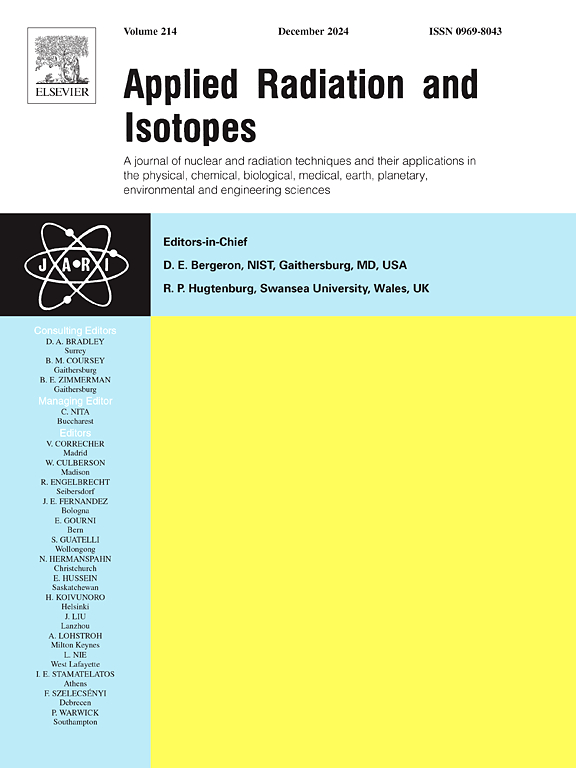Radiosynthesis of [131I]I-Hesperidin: Optimization, physicochemical profiling, and computational insights for targeted radiopharmaceuticals
IF 1.6
3区 工程技术
Q3 CHEMISTRY, INORGANIC & NUCLEAR
引用次数: 0
Abstract
Hesperidin, a citrus flavonoid, has been investigated for its potential health benefits, including anticancer. However, the study of hesperidin as a theranostic agent and its cancer cellular uptake is still lacking. Therefore, in this research, we developed radiolabeling methods of hesperidin with Iodine-131 (131I) for radiotracing and investigating its potential theranostic application. Here, we showed that the radiochemical purity of [131I]I-hesperidin prepared with chloramine-T in methanol or DMSO, iodogen, and iodobeads as a catalyst were 97.75, 79.08, 78.13, and 49.91 %, respectively. The LogP and plasma protein-binding after 24 h of [131I]I-hesperidin prepared by chloramine-T in methanol were 0.54 ± 0.02 and 51.01 %, respectively. It was also stable in PBS for up to two days (RCP>90 %). The cellular uptake assay demonstrated the high and rapid uptake of [131I]I- hesperidin in A549 cells (92.03 % in 30 min), relatively low uptake in MCF-7 (21.30 % in 1 h), and deficient uptake in MDA-MB-231 (3.64 %). Interaction and binding energies of [131I]I-hesperidin-b toward EGFR, HER2, ERα, and ERβ, were −169.910; −131.574; −152.623, and −184.844 kJ/mol, respectively. Considering that the cellular uptake was the highest in A549 cells among the tested cells, the cellular uptake may be related to both EGFR and HER2 receptors. In addition, the interaction and binding energy of [131I]I-hesperidin-b toward AKT1 was −150.939 kJ/mol, indicating the potential [131I]I-hesperidin-b intervention in EGFR/HER2 signaling. Our data suggest that [131I]I-hesperidin-b is a potential radiopharmaceutical, especially for lung cancers with EGFR and HER2 expression. However, further studies are still needed to evaluate the uptake mechanism of [131I]I-hesperidin at the molecular level. Hopefully, [131I]I-hesperidin will provide an opportunity to investigate the biodistribution, pharmacokinetics, and its potential as a targeted therapeutic-diagnostic agent supported with beta decay for cancer cell eradication.
[131I] i -橙皮苷的放射合成:优化、物理化学分析和靶向放射性药物的计算见解
橙皮苷,一种柑橘类黄酮,已经被研究其潜在的健康益处,包括抗癌。然而,橙皮苷作为一种治疗药物及其癌细胞摄取的研究仍然缺乏。因此,在本研究中,我们开发了用碘-131 (131I)放射性标记橙皮苷的方法进行放射性示踪,并研究其潜在的治疗应用。在此,我们发现氯胺- t在甲醇或DMSO,碘和碘珠作为催化剂制备的[131I] i -橙皮苷的放射化学纯度分别为97.75%,79.08,78.13和49.91%。氯胺- t法制备的[131I]橙皮苷24 h后的LogP和血浆蛋白结合率分别为0.54±0.02和51.01%。它在PBS中也稳定了两天(rcpp > 90%)。细胞摄取实验表明,A549细胞对[131I]I-橙皮苷的摄取高且快速(30 min内摄取92.03%),MCF-7细胞对[131I]I-橙皮苷的摄取相对较低(1 h内摄取21.30%),MDA-MB-231细胞摄取不足(3.64%)。[131I] i -橙皮苷-b对EGFR、HER2、ERα和ERβ的相互作用能和结合能为- 169.910;−131.574;分别为−152.623和−184.844 kJ/mol。考虑到A549细胞的细胞摄取在被测细胞中最高,细胞摄取可能与EGFR和HER2受体都有关。此外,[131I] i -橙皮苷-b与AKT1的相互作用和结合能为- 150.939 kJ/mol,表明[131I] i -橙皮苷-b可能干预EGFR/HER2信号转导。我们的数据表明[131I] i -橙皮苷-b是一种潜在的放射性药物,特别是对于EGFR和HER2表达的肺癌。然而,在分子水平上评价[131I] i -橙皮苷的摄取机制还需要进一步的研究。希望[131I], i -橙皮苷将为研究其生物分布、药代动力学及其作为靶向治疗诊断剂的潜力提供机会,并支持β衰变以根除癌细胞。
本文章由计算机程序翻译,如有差异,请以英文原文为准。
求助全文
约1分钟内获得全文
求助全文
来源期刊

Applied Radiation and Isotopes
工程技术-核科学技术
CiteScore
3.00
自引率
12.50%
发文量
406
审稿时长
13.5 months
期刊介绍:
Applied Radiation and Isotopes provides a high quality medium for the publication of substantial, original and scientific and technological papers on the development and peaceful application of nuclear, radiation and radionuclide techniques in chemistry, physics, biochemistry, biology, medicine, security, engineering and in the earth, planetary and environmental sciences, all including dosimetry. Nuclear techniques are defined in the broadest sense and both experimental and theoretical papers are welcome. They include the development and use of α- and β-particles, X-rays and γ-rays, neutrons and other nuclear particles and radiations from all sources, including radionuclides, synchrotron sources, cyclotrons and reactors and from the natural environment.
The journal aims to publish papers with significance to an international audience, containing substantial novelty and scientific impact. The Editors reserve the rights to reject, with or without external review, papers that do not meet these criteria.
Papers dealing with radiation processing, i.e., where radiation is used to bring about a biological, chemical or physical change in a material, should be directed to our sister journal Radiation Physics and Chemistry.
 求助内容:
求助内容: 应助结果提醒方式:
应助结果提醒方式:


